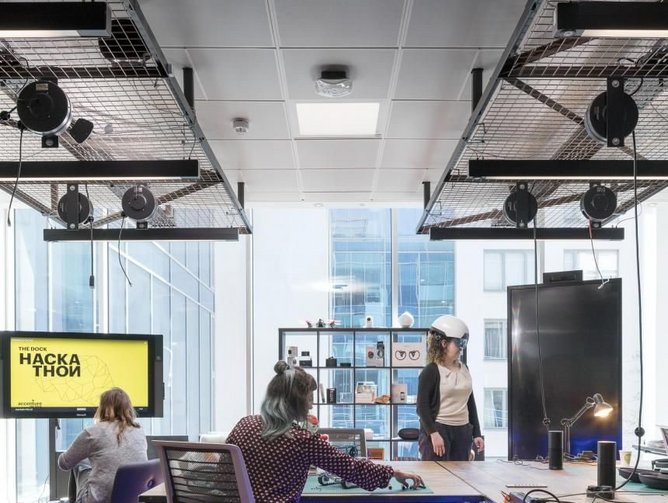Accenture: IT evolution for value realization, not revolution for technology’s sake
The enterprise is entering a new “post-digital” era, where success will be based on how companies can apply new technologies in people-centric ways, creating personalised experiences for customers, employees and business partners. As technological innovation continues to accelerate – with new, more powerful solutions coming to market on an almost daily basis – few people could be blamed for feeling like dinosaurs, watching all the other animals board an Ark with ‘cloud’ written on the side of it. However, while the vast majority of companies have begun their digital transformation journeys, such as migration to the public cloud, the collective journey is still very much in its early stages. “75-80% of all enterprises are doing cloud in various shapes or forms, but if you look at how much of their estates they've actually migrated or leveraged into cloud, it's still fairly small,” comments Philippe Chauffard, Managing Director of Accenture’s Intelligent Cloud Infrastructure division. “While everybody is doing it, a lot of people are still in the early stages.”
Combining a wealth of experience with specialised skills across more than 40 industries, Accenture is a leading provider of professional services at the intersection of business and technology. Employing over 477,000 professionals, the company has empowered businesses of every size to realise their strategy, consulting, digital, technology and operations goals since 1989. Today, in 2019, Accenture’s Intelligent Cloud Infrastructure segment exists on the front lines of a global digital transformation powered by Industry 4.0. Helping guide Accenture’s clients and partners on this multi-thread journey, Chauffard is uniquely positioned to provide insight into both the changing state of the digital transformation game and Accenture’s role in delivering a sustainable, cloud-based future.
In a world where the average length of time between an employee switching jobs has shrunk to 3.2 years for workers aged 25-34, Chauffard’s 31 years at Accenture stand in stark contrast to the modern economy. “It’s true that mine is becoming a bit of an unusual career track, but in my time at Accenture I’ve held so many different roles across different industries and programs – Accenture’s positioning and strengths have given me the opportunity to lead programs that would not have been possible with other companies in terms of scale and complexity,” Chauffard explains. Working across all five continents, his position always focused on infrastructure in some form, which he combines with Accenture’s cloud agenda in his current role, taken on in September 2018. “It's been exciting, and as long as it stays exciting, I'm in the right place,” he enthuses.
In the world of technological innovation and digital transformation, change appears constant and blindingly fast. Chauffard, however, is in a perfect position to observe the slower, more tectonic transformations occurring beneath the surface. This big picture perspective gives him valuable insight into the key strategic enablers of a successful cloud migration, and the ways in which the digital infrastructure industry is maturing to a point where evolution in support of value realization, not revolution for technology’s sake, is the mantra for progress.
“First of all, a key lesson I’ve learned from working on many different initiatives with Accenture’s clients is that technology challenges are not the biggest challenges,” Chauffard explains. “At the end of the day, technology is a means to an end. If you look at the last two to five years, industry disruptions have all been powered by technology evolutions. It’s such an exciting space to be in, but technology adoption only makes sense if it’s business strategy driven.” Chauffard argues that ensuring there is a strong business case for new technological adoption is an increasingly prevalent approach, both as the industry becomes more mature and considered, and also as the power of cloud infrastructure is better understood. “The conversation has shifted,” Chauffard explains. “In the past, a cloud roadmap was drawn up with cost reduction as the focus, and that’s changed. Yes, you still need to save some costs, but what I'm really after are ways to start leveraging those cloud capabilities and features to drive increased flexibility, agility and innovation in my business.”
Chauffard emphasises that agility and flexibility are essential if companies wish to survive and thrive within their ecosystems. “The idea of the ecosystem is essential to this new cloud economy,” he explains. “Every company is part of an ecosystem between customers, partners, collaborators and so on. The pressing question is how to use cloud to become a central piece of your ecosystem, and then use that ecosystem to deliver the most innovative possible services to your customers. This is even more strategic and important for Accenture. We are a people, services and transformation company, and therefore it’s vital for us and for our clients that we are at the centre of our ecosystem. This is why we work hand in hand with our strategic partners – whether it's some of the hyper scale providers like AWS, Azure and Google, or the key platform players like SAP or ServiceNow, or enterprise technology providers like Commvault. Accenture Cloud Innovation Center (ACIC) in Rome is a prime example of co-innovation across the ecosystem.”
Chauffard emphasises that companies need to resist the impulse to buy the “shiniest toys” and carefully consider the business use cases. In addition to the more value realization focused approach to IT transformation he is advocating for, he also notes that, as businesses seek to achieve deeper penetration with their digitalisation strategies, the pace of transformation needs to slow to avoid corporate whiplash. “Four or so years ago, Gartner found that 80% of companies’ cloud transformations were failing, or they said they didn’t feel as though they were seeing the benefits,” says Chauffard. “Those transformations weren’t failing because of the technology. They were failing because the operating model and talent transformation had not happened.”
Chauffard explains that transformation of the operational model alongside a company’s IT capabilities, described by Accenture as its ‘Run Different’ strategy, centres around four key capabilities: Cloud Management and Operations, Cloud Optimisation, Consumption and Security. “They are necessary to have an underlying platform from which to innovate technologically,” says Chauffard. First, Cloud Management and Operations focuses on the ongoing cloud asset management. “To support cloud, you need a whole operating model and the associated talent transformation, and that’s often one of the biggest issues for our clients,” he explains. Ensuring communication and effectively managing talent while avoiding silos is crucial to a successful reincarnation of a company’s cloud management strategy. Second is Cloud Optimisation: ensuring everything from weighing the capabilities of a company’s architecture against the services the company has, to advanced and ongoing optimisation techniques. Third is Consumption Management and Consolidation. “We’ve moved to an ongoing consumption world, so buying and sourcing becomes an ongoing process,” says Chauffard. A company’s capability to manage its consumption of cloud resources efficiently not only reduces cost and administrative work, but also provides information to support the management and optimisation strategies. Lastly, Chauffard explains, is Security. “It’s something that is continuously evolving, and therefore you need to be able to enforce a set of standard security functions and services.” All four capabilities can be applied via a management platform, and choosing and operating the correct piece of software again relies on Chauffard’s advice: transformation, evolution and optimisation need to happen, not for their own sakes, but in support of the overall business case.
“We’re not going to see many more ‘big bang’ – 12 months and we’re done for the next 10 years – transformations. People are becoming more thoughtful,” says Chauffard. “It’s going to be much more of an ongoing migration, evolution and modernisation of the application landscape.” The slower, measured, business case driven approach doesn’t do away with everything and build a new cloud-based company from scratch. “It’s a multi-threaded evolution across multiple applications,” Chauffard explains. “Starting from your existing application landscape, there are going to be some applications that can just be lifted and shifted to the cloud with minimal work and cost. Some will need more of a remediation, and some applications you’re going to have to rewrite from scratch. Some applications will happily stay forever in the legacy system and will eventually die away several years later, because there is no business case to rewrite them or move them or do something with them.” The important step, and what gives Chauffard’s plan its natural, evolutionary pace, is the firm rule that any new applications or technologies are required to be cloud native. This way the progression from legacy to private and public cloud progresses through a stable hybrid approach. “We're going to be in a hybrid world for many years to come,” Chauffard says.
Technological progress is not constant and measured; like evolution it progresses in fits and starts before claiming new ground. Small, incremental replacements of parts of a company’s IT estate, paired with constant optimisation, Accenture and Chauffard believe, is the best method to successfully reconcile the frenetic pace of technology with the evolving needs of the business. “I think the whole approach to defining your cloud strategy, defining your roadmap for your cloud journey, for the prioritisation and for what you're going to leverage from the very wide range of services that are available in the market again needs to be driven by the strategic agenda and the business agenda,” Chauffard concludes. “I think between now and 2022 will be an extremely exciting time. We’re going to see the pace of innovation accelerate, as companies’ evolutions progress and the paradigm shifts. I think I'm in absolutely the right spot within Accenture; I have great expectations for our business in this space.”





